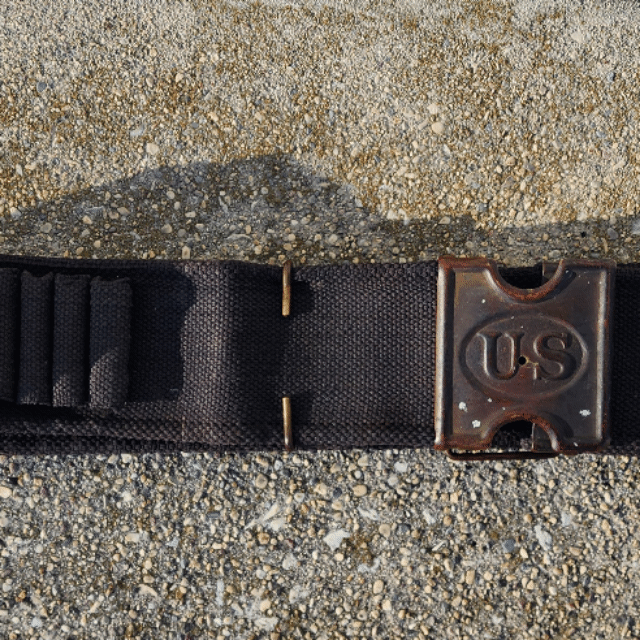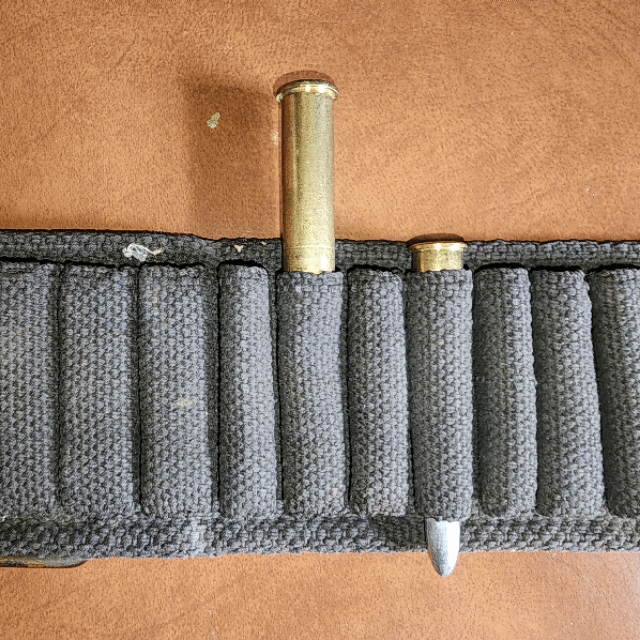Page 1 of 1
50 round belt
Posted: Tue Mar 19, 2024 1:35 am
by King carp
I picked up a 50 round belt i believe for the 45-70 cartridge. It holds a 30-40 round ok. I will have to dig out a 45-70 round to see if it fits. It has a mills and orndorf 1894 patent date on it. I have seen these in khaki and blue but this one is black. Has any of the forum members seen one like this. Any ideas of who would have used it. Thanks for any help in advance.

- 20240318_202636.gif (813.04 KiB) Viewed 3247 times
Re: 50 round belt
Posted: Tue Mar 19, 2024 6:20 am
by butlersrangers
King carp - Photos of the belt ends and back of the buckle, (showing patent & maker's name), would be helpful.
Are the cartridge loops sewn on or woven into the belt?
There appear to be some 'stripes' of darker thread. This was a practice of the Hurlburt Co. and the Spalding Company, to help locate & position sewn on loops.
Possibly, your belt was once khaki and was later dyed Navy blue. Some 'Re-dyed' belts didn't show good stability in staying 'blue'.
I have one that has faded to a weak purple.
There was a need for blue belts after the SAW and an abundance of Khaki ones, (hence the blue dye jobs).
(p.s. - Lots of .45-70 belts only have 45 cartridge loops).
Attached photos show a khaki Hurlburt .30-40 belt and one that was re-dyed to navy blue, but has faded. Note a .45-70 cartridge will not fully fit into the loop.
Re: 50 round belt
Posted: Tue Mar 19, 2024 5:12 pm
by scottz63
Great info. Thanks!
Re: 45 round belt
Posted: Tue Mar 19, 2024 7:58 pm
by King carp

- 20240319_144727.gif (696.31 KiB) Viewed 3174 times
The belt seems to fit a 30-40 round better than a 45-70. The loops are not sewn on but woven together with the belt. It is definetly black with no trace of blue or purple. It has 45 loops. Just a guess but maybe used for funerals? I cannot find much info with a google search. Any other ideas?
Re: 50 round belt
Posted: Tue Mar 19, 2024 8:43 pm
by butlersrangers
I believe your "U.S." buckle may be a reproduction. Original Mills buckles have the last lines of lettering almost running off the edge of the hook.
Too bad someone drilled a hole through your buckle.
Your belt is definitely made by Mills - Orndorf, given the end fittings.
The brass wire 'adapter' may be for one of the types of model 1873 bayonet scabbard leather-frogs.
Re: 50 round belt
Posted: Wed Mar 20, 2024 3:52 am
by Dick Hosmer
Granted I'm looking at pictures, not the real item, the ONLY one which I could see as being "black" is the very first one - all the rest of KC's pics look blue to me, albeit a dark shade. I do not believe that the lettering thing is completely positive or uniform. To me, his passes the test - some originals ARE worse, and the fakes are almost uniformly TOO pretty - but there is a gray area. I THINK that little "rail" is for hanging a leather box of pistol cartridges. The Krag bayonet scabbard always hooked - one way or the other - to the belt itself. It was the TD scabbards that had a couple of odd variations in attachment.
Re: 50 round belt
Posted: Wed Mar 20, 2024 5:45 am
by butlersrangers
I have attached a couple of photos of 1873 bayonet scabbards, that require a wire attachment, in order to be carried on a Mills Belt.
Re: 50 round belt
Posted: Thu Mar 21, 2024 1:18 am
by King carp
The wire "hanger" is not wide enough for a trapdoor bayonet scabbard. Maybe its for a Krag bayonet, sword or as Mr. Hosmer said a cartridge box?
Re: 50 round belt
Posted: Thu Mar 21, 2024 6:45 am
by Dick Hosmer
The TD scabbards with leather loops were made to go ON the M1874 leather waist belt, or the concealed tongue of the 100 RIA experimental belts. The M1885 brass-hook scabbards could be used on ANY belt of the period. There were also some single wire hook scabbards made for testing on the canvas Ft. Lincoln trials belts, which had grommets in them. There were also several different twisted wire adaptors by which a loop scabbard COULD be attached to grommets or over the belt itself, but they were a part of the scabbard, not the belt. The goal was always to hang the scabbard in such a way as not to impeed access to the cartridges.